Abstract
The ability of genetically diverse strains of porcine reproductive and respiratory syndrome virus (PRRSV) to coexist in a 1750-sow farm was assessed through the case study describing a chronically infected farm, and also by an animal experiment involving the use of swine bioassay. The case study employed a program of monitoring sera from suckling, nursery, and finishing pigs for the presence of PRRSV by polymerase chain reaction (PCR) and virus isolation (VI). The swine bioassay tested homogenates, consisting of lymphoid and pulmonary tissues, collected from 60 breeding animals from the same farm. The open reading frame (ORF) 5 portion of selected positive PRRSV detected from sera or tissues were nucleic acid sequenced and their phylogenies compared. The results indicated the presence of 3 genetically diverse groups, designated PRRSV-A, -B, and -C. Sequence heterology ranged from 5.8 to 11% between groups. Sequence homology ranged from 98.7 to 99.8% within groups. Swine bioassay verified the presence of PRRSV-A in 1 of 60 animals, and no evidence of strains B or C were detected. This paper indicates that based on the evaluation of ORF 5, genetically diverse strains of PRRSV appear to coexist, although the frequency and significance of this observation is not understood.
Full text
PDF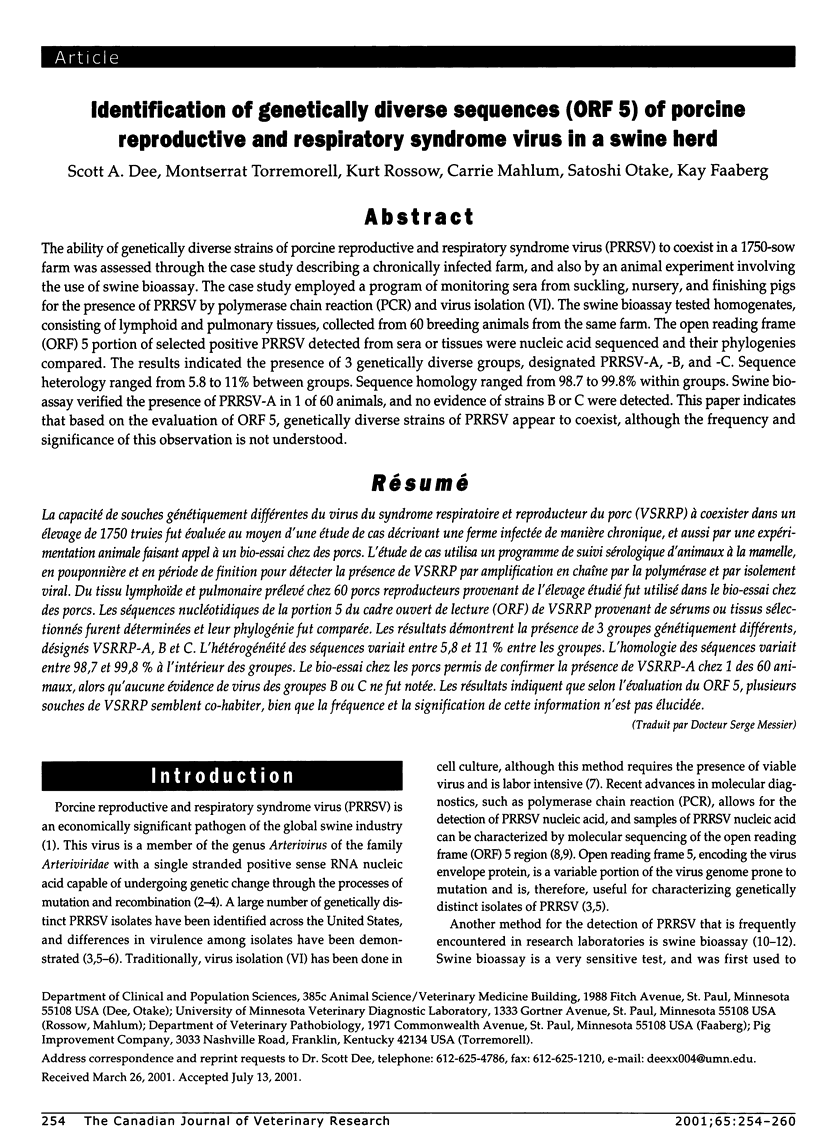

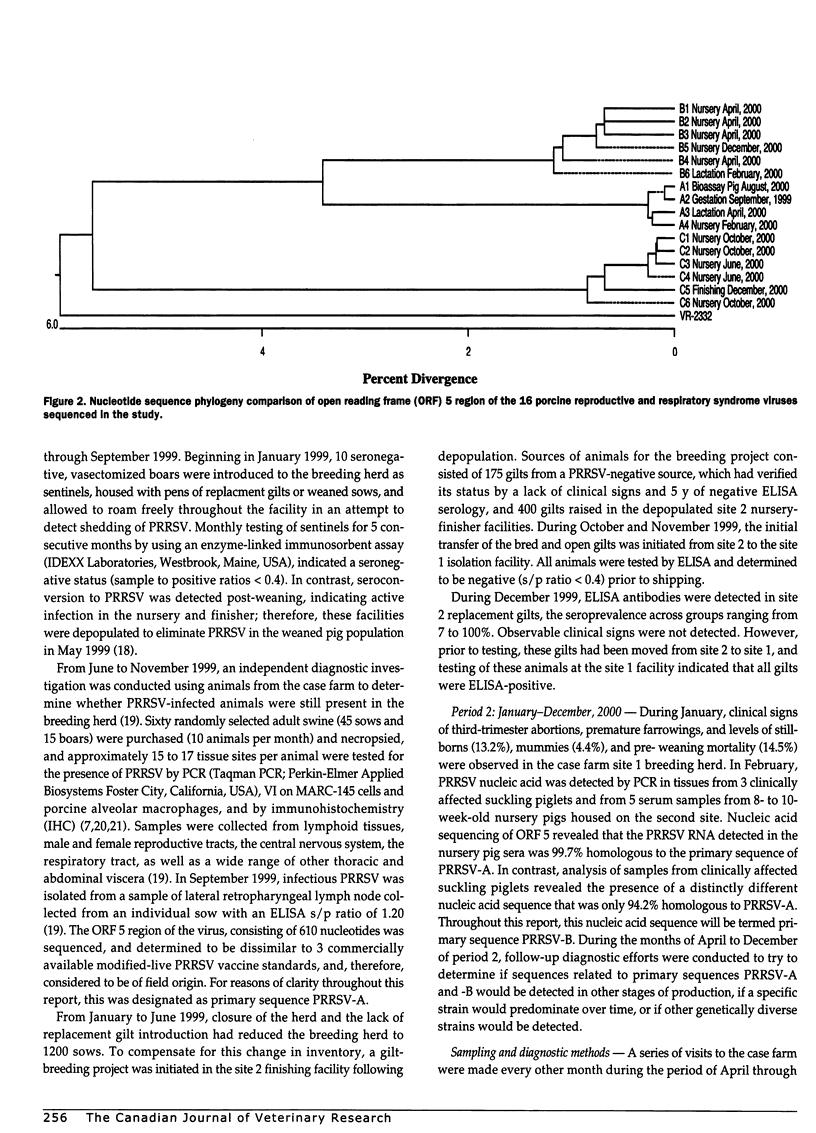
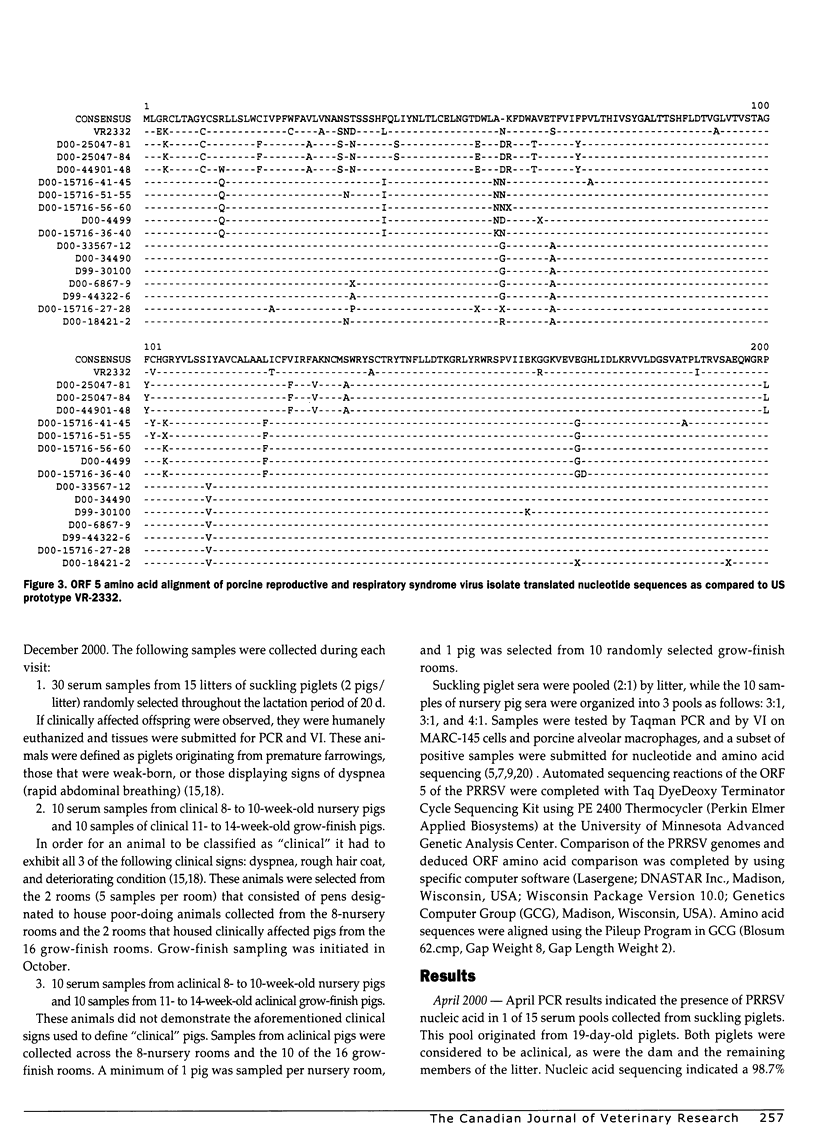
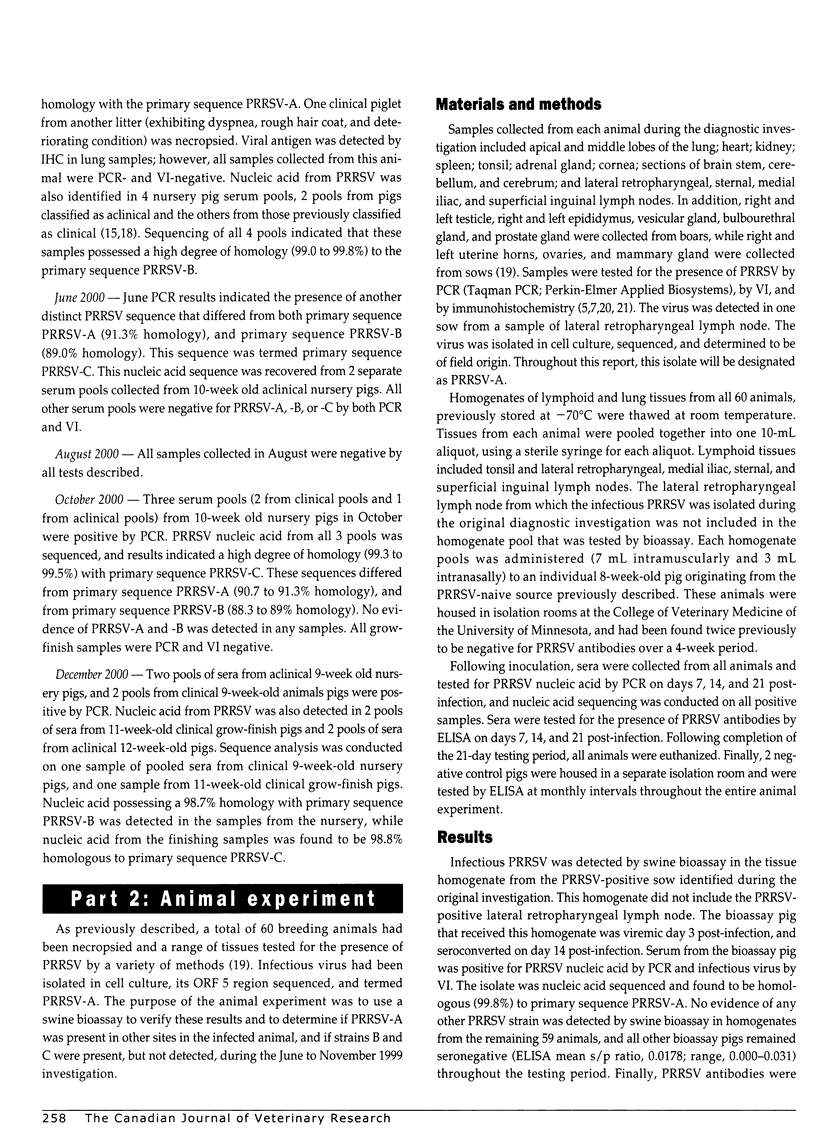
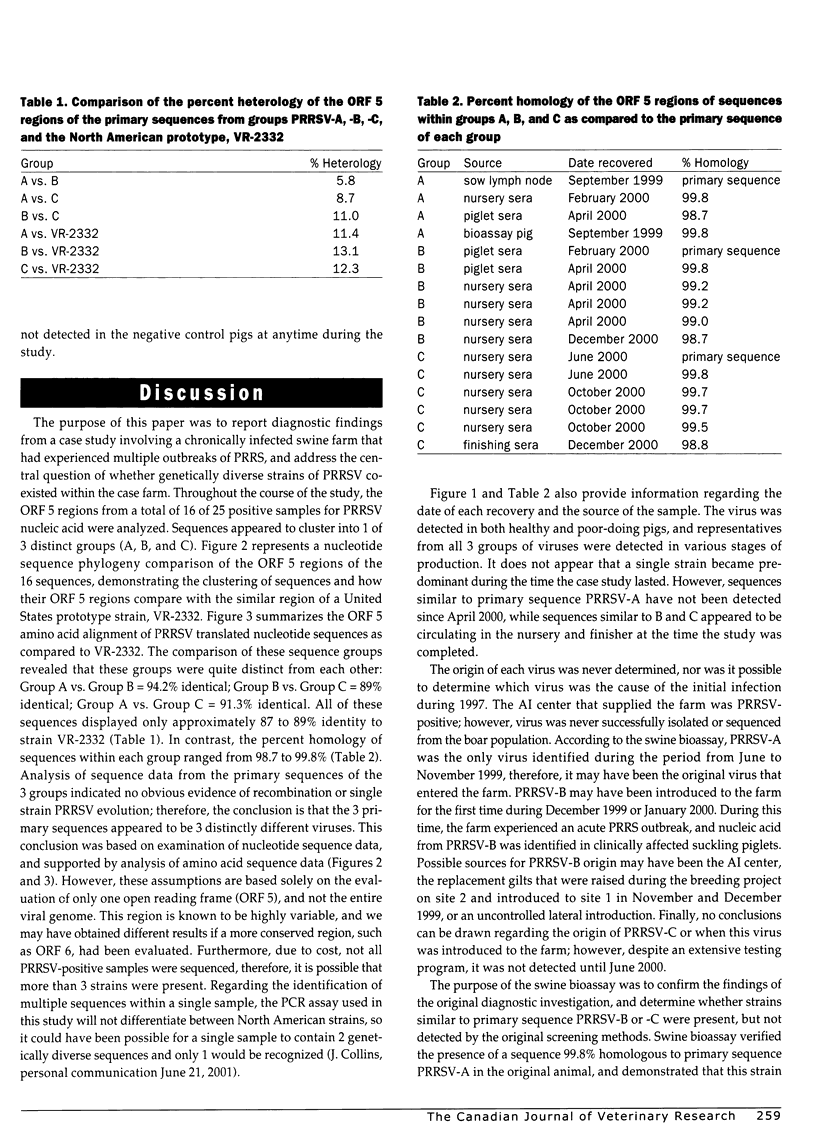

Selected References
These references are in PubMed. This may not be the complete list of references from this article.
- Albina E., Leforban Y., Baron T., Plana Duran J. P., Vannier P. An enzyme linked immunosorbent assay (ELISA) for the detection of antibodies to the porcine reproductive and respiratory syndrome (PRRS) virus. Ann Rech Vet. 1992;23(2):167–176. [PubMed] [Google Scholar]
- Bautista E. M., Goyal S. M., Yoon I. J., Joo H. S., Collins J. E. Comparison of porcine alveolar macrophages and CL 2621 for the detection of porcine reproductive and respiratory syndrome (PRRS) virus and anti-PRRS antibody. J Vet Diagn Invest. 1993 Apr;5(2):163–165. doi: 10.1177/104063879300500204. [DOI] [PubMed] [Google Scholar]
- Bierk M. D., Dee S. A., Rossow K. D., Collins J. E., Guedes M. I., Pijoan C., Molitor T. W. Diagnostic investigation of chronic porcine reproductive and respiratory syndrome virus in a breeding herd of pigs. Vet Rec. 2001 Jun 2;148(22):687–690. doi: 10.1136/vr.148.22.687. [DOI] [PubMed] [Google Scholar]
- Cavanagh D. Nidovirales: a new order comprising Coronaviridae and Arteriviridae. Arch Virol. 1997;142(3):629–633. [PubMed] [Google Scholar]
- Collins J. E., Benfield D. A., Christianson W. T., Harris L., Hennings J. C., Shaw D. P., Goyal S. M., McCullough S., Morrison R. B., Joo H. S. Isolation of swine infertility and respiratory syndrome virus (isolate ATCC VR-2332) in North America and experimental reproduction of the disease in gnotobiotic pigs. J Vet Diagn Invest. 1992 Apr;4(2):117–126. doi: 10.1177/104063879200400201. [DOI] [PubMed] [Google Scholar]
- Dee S. A., Joo H. S., Polson D. D., Marsh W. E. Evaluation of the effects of nursery depopulation of the profitability of 34 pig farms. Vet Rec. 1997 May 10;140(19):498–500. doi: 10.1136/vr.140.19.498. [DOI] [PubMed] [Google Scholar]
- Dee S. A., Joo H. S. Prevention of the spread of porcine reproductive and respiratory syndrome virus in endemically infected pig herds by nursery depopulation. Vet Rec. 1994 Jul 2;135(1):6–9. doi: 10.1136/vr.135.1.6. [DOI] [PubMed] [Google Scholar]
- Guarino H., Goyal S. M., Murtaugh M. P., Morrison R. B., Kapur V. Detection of porcine reproductive and respiratory syndrome virus by reverse transcription-polymerase chain reaction using different regions of the viral genome. J Vet Diagn Invest. 1999 Jan;11(1):27–33. doi: 10.1177/104063879901100104. [DOI] [PubMed] [Google Scholar]
- Halbur P. G., Miller L. D., Paul P. S., Meng X. J., Huffman E. L., Andrews J. J. Immunohistochemical identification of porcine reproductive and respiratory syndrome virus (PRRSV) antigen in the heart and lymphoid system of three-week-old colostrum-deprived pigs. Vet Pathol. 1995 Mar;32(2):200–204. doi: 10.1177/030098589503200218. [DOI] [PubMed] [Google Scholar]
- Kapur V., Elam M. R., Pawlovich T. M., Murtaugh M. P. Genetic variation in porcine reproductive and respiratory syndrome virus isolates in the midwestern United States. J Gen Virol. 1996 Jun;77(Pt 6):1271–1276. doi: 10.1099/0022-1317-77-6-1271. [DOI] [PubMed] [Google Scholar]
- Mengeling W. L., Vorwald A. C., Lager K. M., Brockmeier S. L. Comparison among strains of porcine reproductive and respiratory syndrome virus for their ability to cause reproductive failure. Am J Vet Res. 1996 Jun;57(6):834–839. [PubMed] [Google Scholar]
- Murtaugh M. P., Elam M. R., Kakach L. T. Comparison of the structural protein coding sequences of the VR-2332 and Lelystad virus strains of the PRRS virus. Arch Virol. 1995;140(8):1451–1460. doi: 10.1007/BF01322671. [DOI] [PMC free article] [PubMed] [Google Scholar]
- Park B. K., Joo H. S. Induction of dual infections in newborn and three-week-old pigs by use of two plaque size variants of porcine reproductive and respiratory syndrome virus. Am J Vet Res. 1997 Mar;58(3):257–259. [PubMed] [Google Scholar]
- Suárez P., Zardoya R., Prieto C., Solana A., Tabarés E., Bautista J. M., Castro J. M. Direct detection of the porcine reproductive and respiratory syndrome (PRRS) virus by reverse polymerase chain reaction (RT-PCR). Arch Virol. 1994;135(1-2):89–99. doi: 10.1007/BF01309767. [DOI] [PubMed] [Google Scholar]
- Swenson S. L., Hill H. T., Zimmerman J. J., Evans L. E., Landgraf J. G., Wills R. W., Sanderson T. P., McGinley M. J., Brevik A. K., Ciszewski D. K. Excretion of porcine reproductive and respiratory syndrome virus in semen after experimentally induced infection in boars. J Am Vet Med Assoc. 1994 Jun 15;204(12):1943–1948. [PubMed] [Google Scholar]


